Ubud has been a vortex for artists such as sculptors, woodcarvers, painters and musicians since as long as anyone can remember. The prominence of all this creativity is a result of the residents of Balinese Royalty in Ubud for many generations. With royalty and their entourage came a demand for the arts.and grandiose architecture. To this day many of these grand compounds have been “kept in the family” and handed down from one generation to another ~ compounds comprised of a variety of intricately decorated buildings and always include a temple and one or many shrines.
This we discover as we stroll the village streets and walk into open gateways which are often ornate with carvings and sculptures. “This must be a temple, or a palace..” we think, but is more often that not a private family compound. With Balinese people being exceptionally friendly they welcome us and do not seem bothered by our curiosity of our peeking into their homes, having walked in by mistake. Given that Ubud has such an extraordinary wealth of Hindu Buddhist temples, its easy to confuse home from temple.
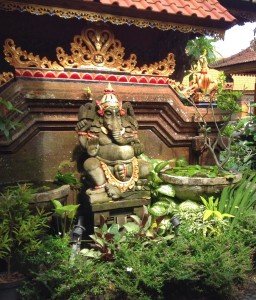 |
| Inside the family compound of a private home of family descended from royalty. Sculpture of Ganesh. (Ben’s favorite Indian god.) |
Ubud developed a reputation for being a place with special “power”, where the sick came to heal. As far back as the 8th century, 1300 years ago, royals and powerful Balinese families sent their sick to be healed in Ubud. The healing is not a modern phenomenon although, the modern incarnation of yesterdays Balinese healers is a huge quantity of spas and treatments such as reflexology, Balinese massage, sound healings, colonics to name a few. As well as a multitude of yoga, meditation, tai chi and so on….
The combination of architecture, the arts, healing properties of the town, and the beauty and kindness of its Balinese population caught the attention of Western artists in the 1930s and continues to this day.
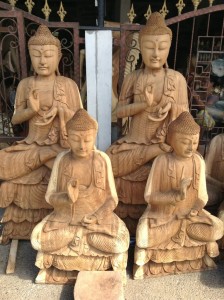 |
| There is a section of Ubud that is one workshop after another of artists’ work. Wooden carved buddha sculptures en masse. |
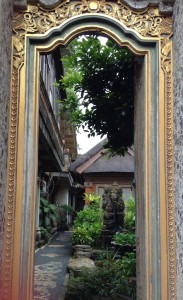 |
| Ornate doorway to a private home on the main street. |
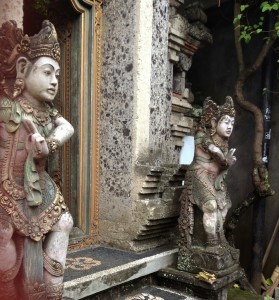 |
| Entrance to a family compound flanked by carved sculptures. |
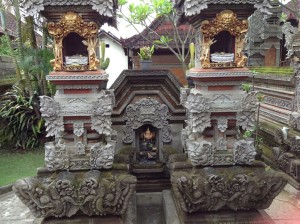 |
| Hard to believe these ornate shrines are very commonplace in a private family compound ~ first thing you see once entering the front gateway. |
On one occasion, we enter into a huge open wooden gateway and the beautifully and colorfully dressed owner welcomes us into the family compound. We accept his kind invitation to show us around. He is an architect who spent over 10 years in Japan, studying solar energy and climate friendly architecture. That’s his day job. But he is Balinese and a third generation Ubud artist, and the art work in his house is simply breathtaking. His personal interest is in preserving a unique culture of delicately carved etching on palm leaf with sharp knives and black nut in lieu of ink ~ a practice that predates the availability of paper. He has a beautiful collection and invites us to take a peak on the third floor art gallery of one of the compound buildings.
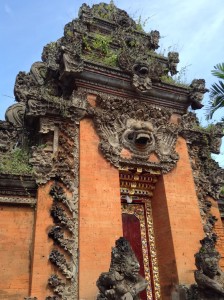 |
| Ornate entrance with gilded doors and carvings to the house of this artist. |
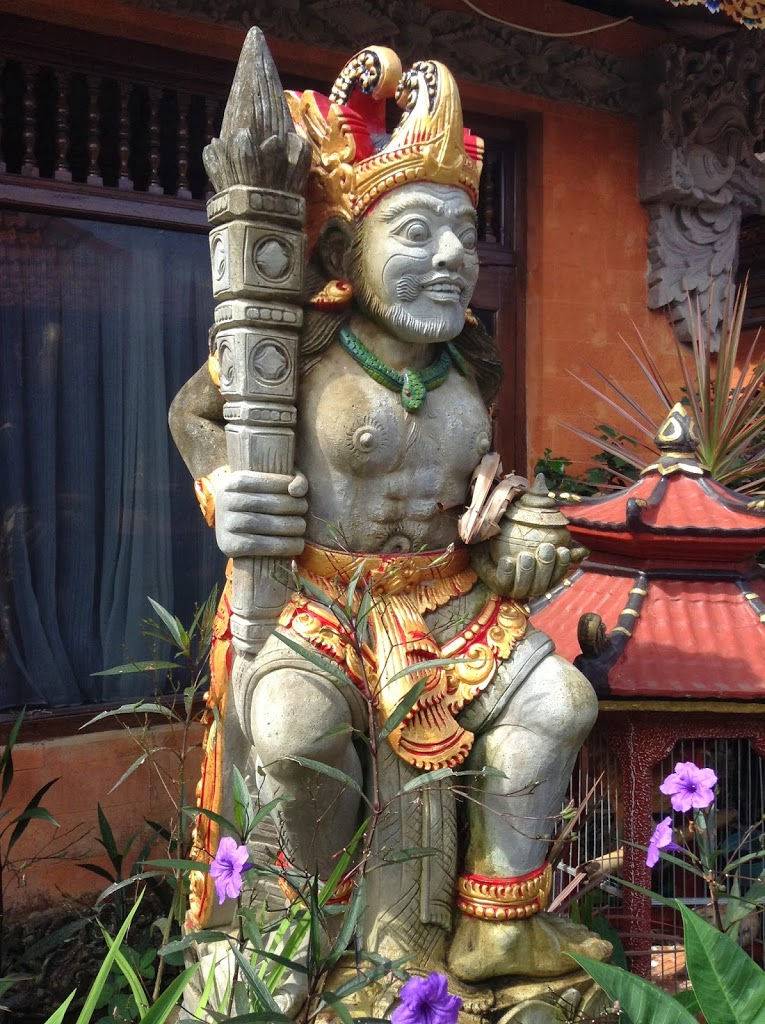 |
| A guardian sculpture inside the compound for protection. |
 |
| I tell Ben, there is no reason he cant dress in such great clothes and colors here. |
Family compounds follow a strict pattern, dictated by Balinese Hindu beliefs. It all works in 9 squares. Any property, no matter how small or large, is divided conceptually into 9 equal sized squares. The first square is for the Gods. The next 5 squares are shared among human inhabitants. Typically this refers to the grandparents, and the youngest of adult sons who becomes the heir of the compound. Wive alwayss join their husband’s family compounds and each family has their stand alone building. All compound family members share common rooms such as the kitchen and open air sitting areas. The remaining 3 squares are for animals and nature.
 |
| View from the 3rd floor art collection over the rooftops of Ubud. |
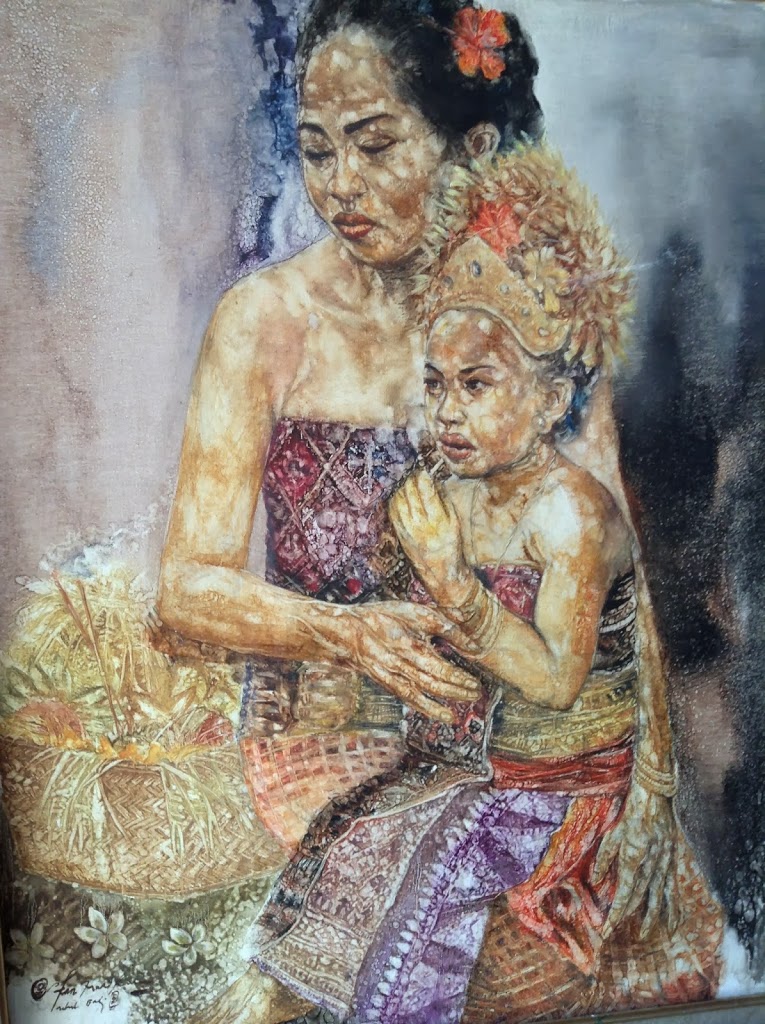 |
| A painting done by the architect/artist. |
 |
| Art gallery with collection of painted carvings on palm leaf. |
 |
| Etching of Lakshmi |












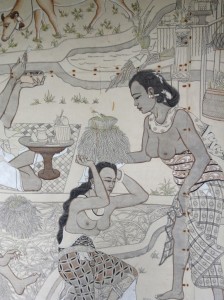
Beautiful! I agree that Ben should go native. Love the etchings.
Ben is enjoying wearing his sarong… Much more comfortable in the heat and humidity than pants. “When in Rome, do as the Romans do”.. is a motto we try to live by when we can.